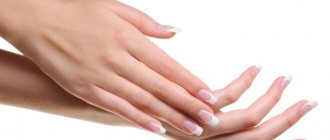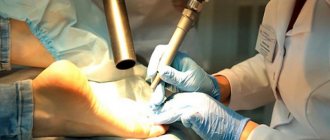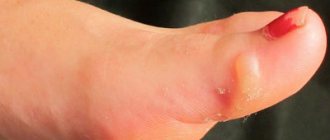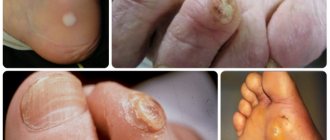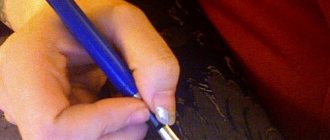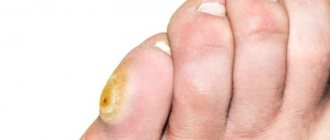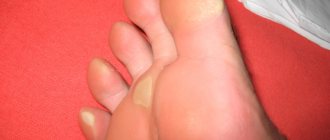What to do with hard calluses?
A hard callus is essentially a dry callus.
Naturally, you need to get rid of it.
Let's take a closer look at some official pharmaceutical products for the treatment of calluses.
Treated with Anticorn Super cream.
It is used to moisturize and gradually soften.
It contains many natural plant components with bactericidal and softening properties.
They are also treated with the oily liquid “Feresol” with a cauterizing effect due to the content of phenol and tricresol.
It also has antimicrobial, anti-inflammatory, bactericidal and softening effects.
They are also treated with a very effective remedy - Roacutane gel.
This gel has a keratolytic effect.
Due to the content of salicylic, lactic, boric, benzoic and citric acids in its composition.
And finally, a few words about the Salipoda patch.
This convenient patch has long proven its effectiveness.
It has a pronounced softening antimicrobial effect.
But before using these products, you must carefully re-read all contraindications and strictly adhere to them.
Interdigital calluses
Sometimes calluses appear in the spaces between the toes on the feet, less often on the hands.
They cause a feeling of great discomfort.
People around them practically do not see them, but they are very painful.
Interdigital calluses are wet calluses.
The interdigital spaces (thumb and second finger, as well as the ring and little fingers) are favorite places for calluses to localize.
Interdigital calluses are common at any age, for both men and women.
Essentially, callus is an adaptive response of the epidermis to prolonged friction or compression.
In which layers of keratinized epidermis are actively built up at the site of mechanical action.
The causes of calluses between the toes are:
- uncomfortable and tight shoes;
- high heels;
- presence - flat feet;
- finger deformities;
- overweight;
- joint diseases (arthrosis, arthritis or gout);
- swelling of the legs.
Calluses: causes, types and methods of control
25.09.2019
When wearing uncomfortable shoes for a long time or simply under the influence of prolonged friction or pressure, thickenings appear on the skin (often painful and unsightly), and it is not so easy to get rid of them. These are calluses . Calluses are essentially hardening of dead skin cells that do not have time to exfoliate. When there is prolonged physical impact on an area of skin, the body perceives this as a threat and tries to protect its integrity by growing a thicker layer of cells on it.
Causes of calluses
Most often, the formation of calluses on the feet is caused by improperly selected shoes. But doctors note that sometimes calluses can indicate various disorders in the body. For example, calluses on the toes can signal problems with the cardiovascular system. If there are such on the right leg, then this may also indicate poor liver . A callus on the big toe may indicate dysfunction in the female organs. Thus, the appearance of calluses can signal the onset of serious diseases in the body, when obvious symptoms are not yet visible.
Types of calluses
- Dry, hard calluses are rough areas on the skin that have been trampled or formed as a result of prolonged physical activity and often require treatment.
- Soft, watery calluses form due to friction, such as from tight shoes. These calluses fill with lymph and are often painful. Here we should highlight one more variety among them, namely, blood calluses . They are also formed due to friction, but filled inside not with transparent lymph, but with blood . This type of callus is especially dangerous because the blood inside indicates that it is located directly on a blood vessel . And this is an open gate for infection to enter the body.
- It is also necessary to distinguish a separate type of calluses - bone calluses , which look like hardening under the skin and feel like a hump to the touch. This type of callus cannot be treated externally and can only be removed surgically .
Treatment of calluses
First, we should talk about the treatment of wet calluses , since they are dangerous for the body. Under no circumstances should you pierce them or squeeze out lymphatic fluid, especially blood . This can lead to infection. There is no need the callus ; this will make it take even longer to heal. It is necessary to determine the cause of the formation of such a callus , eliminate it, and the callus with an antiseptic. If such a callus grows on its own, it is necessary to treat it with an antiseptic as quickly as possible and seal it with an adhesive bandage, otherwise inflammatory and purulent processes may develop.
Treating hard, dry calluses often takes a long time. Of course, it is better to entrust this to doctors or cosmetologists, then you will be sure that everything is done properly without risk to health.
Effective in the fight against dry calluses is a clinical laser method for removing calluses , but before using it you should definitely consult a specialist.
Published in Surgery Premium Clinic
Suppuration of calluses
If calluses are treated untimely and incorrectly, they can become inflamed and fester.
In fact, the appearance of purulent exudate also indicates that the immune system is working fully and is trying to cope with various infections that appear in the outbreak .
Pus threatens to enter the bloodstream, which can result in sepsis, blockage of blood vessels or embolism.
Chamomile baths and hydrogen peroxide are the first means to treat festering calluses, after which you need to consult a doctor or a medical facility.
To prevent the infection from spreading, it is necessary to treat the callus with gel or ointment with an antiseptic.
Then secure this product with a sterile bandage.
Treatment is carried out by applying the drug to the area of the leg affected by the pathological process.
Then it is all covered with a sterile bandage.
And this procedure should be done at least twice during the day, and preferably three.
Purulent forms must be washed with solutions of potassium permanganate, furatsilin or three percent hydrogen peroxide.
With advanced purulent calluses, seeking help from qualified specialists is simply a must.
To remove pus from a callus, it must be drained.
Based on individual characteristics and the degree of complexity of the purulent process, the specialist prescribes therapeutic measures.
Water callus
In most cases, water callus treatment can be done independently. Small calluses are usually not painful and do not break open on their own. Therefore, they are simply covered with a plaster that protects them from injury. If the water callus is large, it causes significant discomfort and is fraught with rupture. It is better to pierce such a “dropsy”. The most favorable time for puncture is considered to be the first day after the bubble appears on the skin.
Piercing a water callus must be carried out with the obligatory observance of certain rules to avoid infection in the callus. First, it is necessary to disinfect the puncture site. To do this, lubricate the water callus with iodine or brilliant green. Secondly, the puncture can only be made with a sterile needle. You can take a regular pin or sewing needle. To sterilize it, you need to hold it in alcohol or heat it over a fire.
The puncture should be made on the side of the water callus, inserting the needle almost parallel to the surface of the skin. Under no circumstances should you pierce the callus perpendicular to its surface, as this will cause the needle to injure the bottom of the callus. To ensure that the fluid outflow from the water callus occurs continuously, it is better to make several punctures. The main thing is not to overdo it and preserve the walls of the bubble. Like a natural bandage, they cover the delicate skin located inside the water callus and protect it from damage and infection.
After the punctures are made, the water callus is gently pressed with a gauze cloth so that all the existing liquid comes out of it. If over time the callus becomes filled with contents again, it will be necessary to repeat the puncture. To prevent the development of infection after a puncture, an ointment containing an antibiotic is applied to the water callus. Then cover the callus with a protective plaster, which should be changed at least 2 times a day and removed at night.
If the opening of the water callus occurs spontaneously and with a tearing of its wall, the resulting wound must be cleaned and disinfected, apply antibacterial ointment and cover the callus with a gauze pad and adhesive tape. The latter will protect the water callus from contamination and injury, creating favorable conditions for its healing.
If an infection gets into a water callus, it is necessary to open it and remove the walls, since in a closed callus favorable conditions are created for the development of the infectious process and suppuration. Therefore, if infected, you should seek help from a surgeon. In compliance with all the rules of asepsis, he will perform an autopsy and initial treatment of the infected water callus, apply a bandage to ensure drainage of the wound and prescribe local antibacterial treatment.
Old calluses and calluses
Old calluses are dry formations that are not immediately removed.
If irritation on the surface of the skin is long-term and chronic, then the callus turns into a lump, which is very painful and annoying.
First you need to steam it and minimize the load on it, remove friction.
Wear only comfortable, “trodden on” shoes.
Most often, such “old” calluses and calluses-bumps form on the soles of the feet.
If you remove the cause of the callus rubbing, it may go away on its own.
Conversely, if the shoes continue to rub, then calluses will appear again and again.
Dry old calluses are removed using a laser beam.
In this case, local anesthesia is used.
There are certain criteria, when met, it is clear that the callus needs to be removed:
- pain when pressing on the callus (on the legs when walking, on the hands when working);
- if the callus is infected and inflamed;
- if the callus is core.
Calluses form on the skin as a result of a viral or fungal infection.
Or a foreign body is discovered in the thickness - a grain of sand or a splinter.
Types of calluses and treatment methods
Gvozdevaya
A rare type of callus.
Does not have a hole or black spot in the middle.
Outwardly it resembles a nail, the head of which is on top.
It has a small round shape.
Rod
A distinctive feature of this callus is its structure.
The surface of the skin acquires a slight compaction, and under it there is a base.
The main inconvenience is severe pain due to the root located in the tissues.
Such a deep callus can be removed by contacting a medical center for hardware or surgical intervention.
There are several ways to get rid of a callus, for example drilling.
Cryotherapy, as a result of which the callus is frozen, and it dies off on its own.
Laser action that evaporates the liquid contained in the callus, which leads to drying of the rod and the formation itself.
Water
A similar callus can be observed when wearing uncomfortable shoes.
A blister appears that is filled with blood or lymph fluid. The outer skin is thin and easily torn from external influences.
A watery callus should not be pierced or picked off on its own. The treatment procedure is aimed at eliminating mechanical effects at the site of injury.
As a result, the neoplasm will heal on its own, and the contained lymphatic fluid will dissolve and help restore the skin.
IMPORTANT: If the bubble is destroyed, you should disinfect it and then take care of the injury site as if it were a regular wound. Regular treatment should be carried out with alcohol, hydrogen peroxide, furatsilin solution or iodine.
Dry
Occurs in various parts of the body. It is a small keratinized part of the skin. It feels hard and unpleasant to the touch.
Treatment should be carried out even in the absence of painful symptoms.
To do this, steam your feet in warm water with various additives such as soda, soap, potassium permanganate or tea tree oil.
Corns
This callus is similar to the one described above.
However, it only appears on the soles of the feet.
It has no definite boundary and varies in size.
The cause of the appearance is general dry skin, frequent walking and wearing hard shoes.
Cone
REFERENCE: Like any disease, it is easiest to cure a callus at an early stage by regularly lubricating it with an emollient cream before bed.
It appears as thickenings on the big toes. Sometimes it causes discomfort when walking.
The cause may be heredity.
Development occurs for no apparent reason.
Bumps also occur when wearing uncomfortable shoes for a long time.
If the callus is exposed to regular mechanical stress, it can turn into a bunion. This type of callus occurs on the big toes near the joints and contains fluid inside.
The result is severe pain when walking.
Treatment for a bump or bunion should begin by changing your shoes to more comfortable ones. If the callus does not cause pain and does not grow, then there is no reason to worry. But when it becomes a hindrance, you should visit a surgeon.
Outdated
Without timely action, the rubbed parts of the skin turn from new calluses into old ones, the skin on which is keratinized. Such formations are most uncomfortable on the toes. The treatment is long and difficult. Modern pharmacology provides many means to get rid of rough skin. Their action is based on softening and then removing the growth.
The most well-known method for removing calluses on the feet is cutting. To do this, you need the following: a bath with hot water, soap and soda.
- Keep your feet in it for 15 minutes.
- As a result, the old skin will become softer and the top layer can be removed.
- Then apply a patch or lubricate the area with salicylic acid.
The procedure is carried out carefully. The drug should be kept away from healthy skin to avoid damage.
The medicine lasts for several hours. The patch or bandage is then removed and the softened skin is removed as much as possible. The process can be repeated several times, depending on the degree of neglect of the callus.
Root
Black or black-spotted callus. This formation indicates the location of the root under the skin. The blackhead has a round, keratinized surface. The cause may be fungal diseases or unsuitable shoes. When a black dot is clearly visible on the callus, you should turn to laser treatment or cryotherapy.
Soft callus
In this case, the soft formation could have originally been a water callus that was damaged. It looks like a small wound with peeling skin. It needs to be given serious attention, since the damaged area of the skin can easily become infected.
If such a formation is detected, immediately disinfect and do not tear off the skin, as it serves as protection against microorganisms. After disinfection, cover the injury site with a bandage.
Which doctor should I contact for a callus?
The treatment and removal of calluses, in particular on the feet, is carried out by different doctors - dermatologists, cosmetologists, dermatocosmetologists and podologists.
But it is best to be treated by a podiatrist, because he is a specialized specialist on these issues.
Diseases of the cardiovascular system and diabetes mellitus threaten the appearance of purulent calluses.
Therefore, in this category of patients, it is especially important to properly and promptly treat emerging calluses and preventively remove the reasons why they appear.
Experienced podiatrists successfully combat purulent inflammation and lymph flow.
Sometimes antibiotic therapy is indispensable.
If the infection is very serious, then it is necessary to take pills and apply local treatment.
Special ointments and compresses.
And understand that if self-medication at home is ineffective, you need to contact a specialist as soon as possible for effective treatment.
What is a callus?
A callus is a thickening on any part of the human body. It is caused by the regular process of friction of the skin with any object.
It often appears on the feet due to improperly selected shoes, hosiery, or due to the special structure of one or both feet. Callus has two main types.
Depending on the structure, it can be skin or bone.
- The first type is the most common and appears to be a thickened part of the skin. The reason for the appearance is the body’s reaction to close contact with the surface of something.
- Callus differs in its structure. It can appear after a fracture in the form of a new growth from bone tissue.
REFERENCE: Patients with psoriasis, flat feet, diabetes and people with a lack of vitamins in the body, especially vitamin A, are predisposed to the appearance of calluses.
Complications of calluses
Failure to pay attention to calluses can lead to dangerous and unpleasant consequences.
Especially wet, rod and water ones.
But the presence of rod formations causes severe pain and discomfort, and the presence of wet and rod formations often leads to infection.
Which threatens with an abscess, abscess, and in advanced cases even gangrene.
Corns lead to cracks on the plantar surface of the feet.
At the same time, walking is very painful.
Secondary infection - bacteria and fungi - easily penetrates through these cracks.
The appearance of calluses is often caused by a viral infection.
You definitely need to get rid of it; just removing the calluses will not be enough.
General treatment with antiviral drugs is mandatory.
You need to remember that calluses are not such a harmless thing, and take them seriously.
Callus hurts: how to remove and where to remove
Today, there are various ways to get rid of calluses and corns.
They use special tools and devices.
Various techniques are used:
- surgical excision;
- removal using a special device with grinding attachments (cutters);
- cryodestruction (freezing with liquid nitrogen);
- using a laser beam.
The most effective, reliable and safe method is considered to be using laser technology.
Using a carbon dioxide laser beam, the keratinized epithelial layer is evaporated layer by layer without damaging healthy skin.
The main advantages of using a laser to remove calluses are:
- the presence of bloodlessness and complete sterility, since the laser beam causes a bactericidal effect;
- when removing calluses (at one time), scars and other defects do not form;
- rapid rehabilitation (after surgical interventions you can immediately “be in service”).
Such removal can be carried out in specialized offices and clinics where there is the necessary equipment and specialists.
